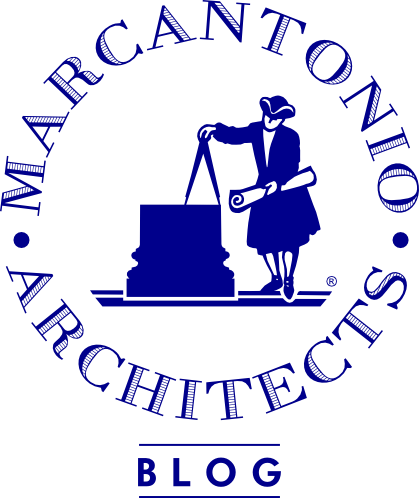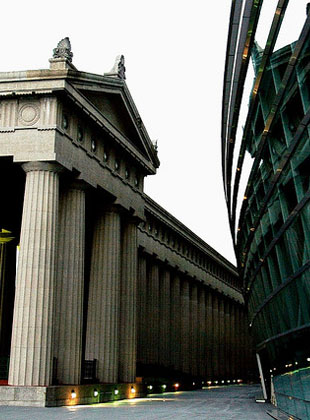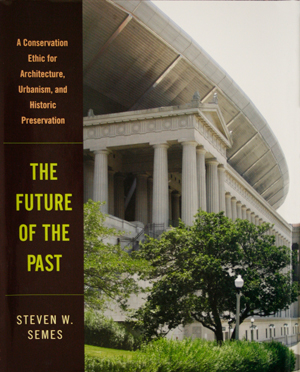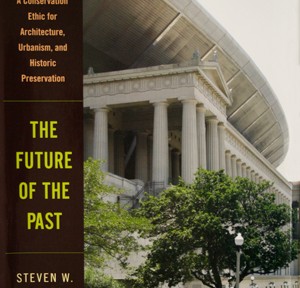My review of Steven Semes’ book The Future of the Past is up at the American Arts Quarterly website. Here it is in its entirety below.
‘The Future of the Past,’ by Steven W. Semes
The Future of the Past is not merely about architectural preservation, as the title might at first glance suggest, but rather more ambitiously about the conservation of the West’s patrimony of traditional architecture and urbanism. As such, Steven Semes enters a much more difficult arena than he faced with his Architecture of the Classical Interior (W.W. Norton & Company, 2004). In the war—and it really has been a war—to preserve our cultural inheritance, the stakes, financial and ideological, could not be higher. Modernism began its visible march almost a century ago with the goal of razing the traditional fabric of the world’s cities, starting with Paris, as an outward expression of the secularism and positivism which had swept clean the fabric of the traditional mind. For the financial opportunists, modernism provided the perfect cover for their lack of pietas, that ancient virtue of honoring the past.
It took half a century for the reaction, and the traditionalists have scored a number of hard-fought victories since then. One of the earliest, and perhaps the most famous, was the saving of Grand Central Station in New York City. Thanks to a preservation movement which rose from the ashes of the shocking demolition of Penn Station, that great pile was shielded from a wrecking ball aiming to make room for the PanAm building. And today it remains a glory to behold, at least as long as you block your view of the revised PanAm building, now sited directly behind and looming menacingly. The victory was not absolutely perfect. Yet it gave a generation hope that they might pass on to their children all the substance and most of the spirit of that which was handed down to them by their parents.
Since that time, there have been other victories, but they have been less and less complete. While, at the beginning of the preservation movement, one might have expected an entire building to be preserved, now one hopes only for the façade. A double standard has become settled: the integrity of modernist icons is defended with a ferocity and a record of success which the traditional side can only envy. What is more, renovations of and additions to traditional buildings are expected to be modernist rather than traditional. The preservation cause, launched by laymen to preserve the patrimony, has essentially been co-opted by an overwhelmingly modernist profession to hem in the substance of that patrimony, and to banish its spirit permanently. The traditionalists are hoist with their own petard.
Enter Semes onto the battlefield, and already his book is being received gratefully by traditionalist laymen and professionals as a weapon the modernists will have to reckon with. The book is part history, part philosophical analysis, part architecture textbook and part prescription. It helps the reader understand both modernist architecture and traditional architecture, and their formal and intellectual incompatibility. Semes’s goal is to build a foundation for a new “conservation ethic,” one which will unite architects, planners and preservationists, and which does not seek to encase traditional buildings and neighborhoods “like insects in amber,” but rather to manage and cultivate “something that is alive, as one conserves…a garden.”
The book’s strongest feature is its attempt at a formal analysis which rises above the category of style. Semes enumerates seven principles of traditional architecture: Space, Structure, Elements, Composition, Proportion, Ornament and Decoration, and Character. All traditional buildings, regardless of their style—Byzantine, Romanesque, Gothic or Beaux-Arts—handle these seven principles in the same way. For example, in all traditional buildings and urban plans, space “takes the form of a recognizable figure, which is to say a traditional architectural space may always be seen as a room, whether interior or exterior.” The structure is always a “rational and visually convincing representation in the building’s design of the tectonic and material forces acting upon and within it.” “Elements” refers to the principle that the whole is composed of nameable parts, and each part is another whole unto itself. So a city is composed of the elements of streets and squares, which are composed of the elements of façades, which are composed of aedicules or other motifs, which are themselves composed of pilasters and entablatures, etc. These seven principles unite all traditional work.
Modernist buildings, in stark contrast, essentially reverse the traditional way of handling these seven principles. For example, Semes writes, modernist space is “not a body; it is a void typically conceived as extending infinitely in all directions, and its essential characteristics are neutrality and endlessness.” Modernist structure is not “readable as a visual expression of stability and repose…[but] a means of declaring independence from the supposed imperatives of gravity.” And so far as elements are concerned, modernist architecture “often presents us with configurations of form and space that we recognize with difficulty, and sometimes not at all.”
Thus Semes argues fairly convincingly that while a Gothic building fits coherently into a Byzantine neighborhood, and while there is no incongruity between a Renaissance pile and its Beaux-Arts addition, a modernist intervention in a traditional context is incoherent. Modernism is not a style, in the sense in which the word is applied to traditional work. Rather, it is the very inverse of tradition. The chief problem with the introduction of a modernist intervention into a traditional district is not that there is a clash of styles, but rather that modernism suggests rupture rather than continuity.
The middle section of the book outlines the nature and significance of that rupture. It was consciously sought after by modernists, both in new construction as well as in the preservation of existing monuments, as an expression of their Hegelian view of history. Modernist architecture must be built because history demands it, so the refrain goes, whether it is a small-scale addition or a new neighborhood. It is the architecture of our time. So far as preservation is concerned, each intervention must make evident its chronological provenance so that there can be no confusion about when a particular piece was added. Thus, to preserve a building or neighborhood in such a way as to harmonize seamlessly with it is to falsify history itself. He does reveal this historicist fallacy for what it is, rightly concluding, “there is no ‘spirit of the age’ independent of the activities that are perceived to manifest it, the future depends entirely on our own choices, and these are not determined by any historical necessity.”
The question of rupture is at the heart of Semes’s argument that traditional architecture be granted more latitude. Yet he does not speak to it with all the clarity and consistency one might expect. At times the idea of rupture is presented as substantively as the modernists intended it. For Semes, rupture “challenge[s] our sense of collective and personal identity, revealing conflicting ideas and values that extend well beyond questions of architectural form.” He writes: “if the city is the physical form taken by a community to represent itself, then the conservation of our cities is tantamount to the care and promotion of civilization itself.” He also suggests:
While the debate between traditionalist and modernist positions often seems to be about architectural style, it is more accurately understood as an argument about the nature of time, history, and progress, and the ways our conceptions of these influence the kinds of interventions we find appropriate in any given setting.
For the most part, however, he dismisses the relevance of the philosophical problem and argues the opposite of the above, namely that the conflict does not extend beyond architectural form after all. He says that the Marxist roots of modernism need not be taken seriously anymore, because
global confidence in a predetermined…pattern of progress in history has largely disappeared from the world of politics, economics, and international affairs. Since the fall of Communism—the political expression of Marx’s historical determinism—it seems that nothing is inevitable after all.
The architects represent the last remnant of Hegelian thinking, a highly debatable point, in my opinion. This book was published shortly after a national election in which a number of the candidates drew direct connections between themselves and Marxist academics and the Progressive Era. Nevertheless, Semes summarizes:
And this is the heart of the matter: Traditional and modernist architecture in their “pure” states are fundamentally irreconcilable, not because they are different styles representing different tastes, ideologies, or historical periods, but because the formal premises on which they operate are antithetical.
It is unsatisfying to see the conflict between modernism and tradition reduced to the question of form. As a consequence, Semes must argue the surprising point—considering that this is a book intended to argue that the traditionalist side has been holding the torch for civilization—that a traditional building in a modernist context is also incoherent. He claims:
This book is not an argument against modernism or in favor of classicism; rather, it is an argument for continuity and wholeness, regardless of style. A new modernist building in a modernist setting may be as welcome as a new traditional building in a traditional setting.
Here more questions are raised than are answered. For what defines a modernist setting, what critical mass must be reached, such that a traditional building represents rupture, when it is modernism which represents a rupture in the larger context of Western civilization? Is a block of modernist buildings significant enough to justify ruling out traditional interventions? Must modernist buildings and neighborhoods that have become “historical” be preserved? Does not a traditional building in a modernist context of any size represent “wholeness” in the larger scheme of things? Semes keeps his distance from these questions.
Having consigned historicism to the history books, Semes returns to his strength in the second half of the book: formal analysis. He is good at dissecting the problem faced by an architect charged with the preservation of a structure. Should he take Viollet-le-Duc’s approach of slavishly seamless integration, or that of John Ruskin’s radical non-interventionism? Or Giovannoni’s middle ground, favored by Semes? He dedicates one chapter to each of four possible approaches: literal replication, invention within a style, abstract reference and intentional opposition. The historical examples he provides are extremely instructive. And the rehabilitation of Rome’s great early twentieth-century classicist, Brasini, is particularly edifying.
Yet his exposition does not jibe perfectly with the argument established in the first half of the book, i.e., that modernism represents rupture for reasons other than style. These chapters are essentially about style, and as a consequence it is difficult to make sense of a couple of the examples Semes provides. The chapter on Abstract Reference presents a parade of modernist insertions which make the lamest attempts to fit into their traditional contexts. The last example is Léon Krier’s Jorge M. Perez Architecture Center at the University of Miami, a modernist campus. Following Semes’s argument for continuity and wholeness, one might expect him to criticize the building, as its spatial conception is quite at odds with that of the university. Yet he praises it for fitting in on stylistic grounds. Says Semes: “Its eclecticism allows the building to offer itself not as a rebuke to the modernist buildings around it, but as a mediator.”
More egregiously, in the chapter on Intentional Opposition, Semes includes Michelangelo’s Campidoglio and Capitoline Hill, comparing them to Pei’s Grand Louvre and Wood & Zapata’s Soldier Field in Chicago. Semes is rather unclear as to why, other than to state that the visions for each were radical in their day. The lesson that architectural unity is supplied by a consistent conception of Space, Structure, Elements, Composition, Proportion, Ornament and Decoration, and Character appears to have been forgotten.
These apparent contradictions make Semes’s argument less convincing. They seem to stem from his unwillingness to define the telos of the city, the “ideas and values that extend well beyond questions of architectural form” and toward which those forms point. Nevertheless, the book has a great number of strengths. It speaks in common-sense terms, it is didactic and approachable, and the laymen who are in the trenches fighting a profession which is overwhelmingly uninterested in protecting and building upon the spirit of the received patrimony will find powerful ammunition in it.
American Arts Quarterly, Volume 27, number 2.



